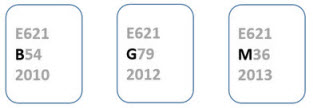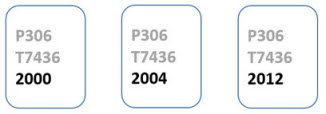3.10 How to Find a Book by its Call Number
We’re not trying to turn you into a librarian but we do want you to be an independent and successful researcher who can locate the materials you need. For this reason, it’s important to understand how call numbers work. You probably know that the purpose of call numbers is to help find items in the library. However, unless you have experience using a research library, chances are that you’re not familiar with how our call numbers work.
Like most academic research libraries in the United States, the ISU Library uses the Library of Congress Classification System to organize its books and journals. The first thing you need to know about the Library of Congress Classification System is that it is an alphanumeric system – meaning its call numbers are composed of both letters and numbers. Books are arranged on the shelves in that alphanumeric order, which means that the letter order follows alphabetical order (A-Z) and smaller numbers come before larger numbers. Call numbers are made up of at least two (and usually more) alphanumeric lines that describe a book’s subject and other attributes and indicate where it’s located in the library.
When you see Library of Congress call numbers on the spine of a book, the call number will be stacked in several short rows. In library catalogs and library discovery tools like Quick Search, you’ll typically see the call numbers in one long string with spaces in between each section of the call number. Here’s an example of the same call number in these two different formats:
| On a book spine
ML419 |
In Quick Search
ML419 K495 S313 2006
|
In both formats, each row or section signifies a different part of the book’s description. The first row is a code that indicates the book’s subject, while remaining rows are code for the author, and so on. Luckily, it’s not necessary for you to know or understand what the letters and numbers actually signify (but if you want to know what each piece of the code means, you can look at the basic outline from the Library of Congress). The important thing to remember is that in order to find a book, you need to understand how call numbers are read and arranged.
Here are the basic rules for reading a Library of Congress call number:
- Each section (except for the publication year) begins with letters and is followed by numbers. Letters in each section are sorted before the numbers, in alphabetical order.
- Numbers in the first alphanumeric section line are sorted as whole numbers. (In the example above, the 419 in the first section represents the whole number 419, or four hundred nineteen.)
- Numbers in later alphanumeric sections are sorted as decimal numbers. (In the example above, the 495 in the second represents .495 or 0.495, and the same rules apply to the 313 in the third section: you read it as 0.313.)
- The final section may consist of four numbers with no letters. This is the publication year.
Practice Reading and Arranging Call Numbers
Let’s look at some examples that show call numbers arranged in correct order. We’ve emphasized the areas to consider, step by step through each segment.
1. Sort Alphabetically
As shown below, a single letter sorts before a two-letter combination starting with that same letter. So, D comes before DG, which comes before DP. Similarly, DP comes before G. The letters work the same in every line of the call number – just put them in alphabetical order.
If all your call numbers start with different combinations of letters, this is as far as you need to go to sort them into the correct order. Just put them in alphabetical order.

In the example here, this is all the sorting we need to do to get these call numbers in the correct order. However, you’ll often need to move beyond the first letter(s) in order to figure out how a particular set of call numbers should be arranged.
2. First letters match? Sort the first segment numbers!
For call numbers that start with the same letter(s), you’ll need to move on to sort the numbers in that first section.
Remember, the number in the first segment of a call number is sorted as a whole number.
Thus, TK9 comes before TK531, which comes before TK5102, and so on. Sometimes this number can include a decimal, which comes in between whole numbers, so TK5102 comes before TK5102.5, which comes before TK5103.

In the example here, once again this is all the sorting we need to do to get these call numbers in the correct order. However, in other cases it’s likely you’ll need to move beyond sorting only the first section of letters and numbers. This is shown in the next example.
3. First segment matches? Proceed to the second segment!
You don’t need to compare the second segments of the call numbers unless the first lines match exactly, as is the case here with E621. The next step is to look at the letters starting the second lines and put them in alphabetical order. In this first example, this is all the sorting you need to do to get these call numbers in correct order.

The second example here below is more complex, since the second lines all begin with the letter K. This means we must now sort by the numbers that follow K.

This is where things can get tricky. The numbers in the second segment of the call number are decimals.
The call numbers in the QA300 example above are in the correct order. If you need help seeing this, imagine adding an invisible decimal point to the numbers in the second line, like this:
.35
.3713
.52513
.53
.635
Adding imaginary zeros to the ends of the numbers until they are all the same length can also help with visualizing this. Again, this is now all the sorting you need to do in this example to get the call numbers in the correct order.
4. First and second segments match? On to the third segment!
It’s not unusual in academic library collections for there to be a third alphanumeric segment in a call number.
If the first two segments are identical, as in the examples below, you will need to sort by this third segment. This works the same way as the previous segment: alphabetical order and then decimal numbers.

5. Date of Publication
The final part of a call number is often the year of publication. Not all call numbers include a publication year, but if it’s present and all other sections of the call numbers are identical, you can sort the call numbers by putting the publication dates in chronological order.

You will see call numbers that are identical up to the publication year when the library owns more than one edition of a book. For one example, Harold Bloom’s literary analysis entitled Fyodor Dostoevsky’s Crime and Punishment was first published in 1988, then significantly revised and republished in 2004. The library owns both the 1988 edition (PG3325 .P73 B55 1988) and the 2004 edition (PG3325 .P73 F964 2004).
